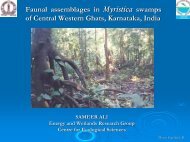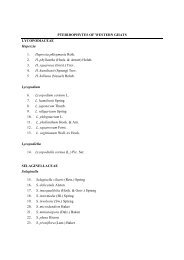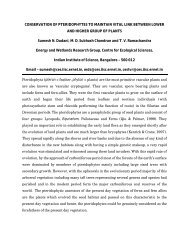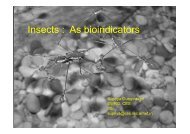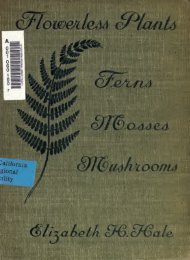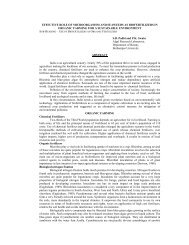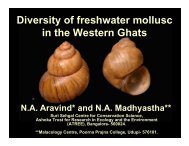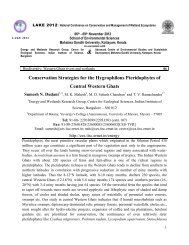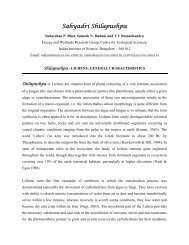a brief comp a brief comparison of modern pteridophyte arison of ...
a brief comp a brief comparison of modern pteridophyte arison of ...
a brief comp a brief comparison of modern pteridophyte arison of ...
You also want an ePaper? Increase the reach of your titles
YUMPU automatically turns print PDFs into web optimized ePapers that Google loves.
114 Indian Fern Journal Volume XXVI (2009)<br />
author believes there is actually a very long way to go before anyone can interpret such<br />
results accurately.<br />
At present the Kramer & Green scheme is given more weight here and felt to be<br />
more reliable than much <strong>of</strong> the molecular scheme, though with a number <strong>of</strong> modifications.<br />
But rather than abandoning it, the molecular scheme should also remain in mind, if not<br />
always at the forefront, and while still being able to be superceded by morphological<br />
considerations.<br />
Some <strong>of</strong> the "genera" recognised molecularly that the present author finds far too<br />
similar morphologically to be worthy <strong>of</strong> generic separation are placed as follows: Ptisana<br />
belongs to Marattia; Bierhorstia (and Sphenomeris) belong to Odontosoria; Paraceterach and<br />
Paragymnopteris belong to Notholaena (for both typification reasons and the morphological<br />
closeness <strong>of</strong> N. American and Old World plants); Haplopteris belongs to Vittaria;<br />
Pentarhizidium belongs to Matteuccia (and not to Onoclea); Wibelia and Humata belong to<br />
Davallia. Others may be seen in the list <strong>of</strong> genera below.<br />
THE THE THE CHINESE CHINESE SYSTEM SYSTEM<br />
SYSTEM<br />
Due to its position adjacent to India and its being a much richer part <strong>of</strong> the same<br />
Sino-Himalayan plus SE Asian fern-flora, the situation that pertains in mainland China is <strong>of</strong><br />
particular importance to pteridologists in the Indian region. However since the Pteridophytes<br />
<strong>of</strong> the Flora Reipublicae Popularis Sinicae (1959- 2004) were published under Ching’s<br />
system <strong>of</strong> 1978 it remains the <strong>of</strong>ficial policy to stick to that system and not make changes<br />
to it. This means that in contrast to other regions, where important fundamental change has<br />
occurred as time and research-based understandings went on and advances were made, the<br />
mainland Chinese system, which is effectively <strong>comp</strong>ulsory, has remained in the same state<br />
as during the era <strong>of</strong> Pichi Sermolli and Ching some 30 years ago. The retention <strong>of</strong> excess<br />
families and genera - and it has to be said that Ching was responsible for many more <strong>of</strong><br />
them than any other <strong>modern</strong> worker - has resulted in a system where most ranks are actually<br />
utilised one step too low in <strong>comp</strong><strong>arison</strong> to the rest <strong>of</strong> the world. What might be subfamilies<br />
elsewhere are <strong>of</strong>ten families in mainland China, and subgenera and sections are frequently<br />
treated at the rank <strong>of</strong> genera. The work done elsewhere for the last 20 years or more, even<br />
by the outstandingly careful and thorough Japanese botanists, for example, on generic<br />
revision and monographing is <strong>of</strong>ten simply ignored, even when some <strong>of</strong> the Chingian genera<br />
(e.g. the "athyrioid" i.e. Woodsiaceous "genera" Allantodia, Callipteris, Diplaziopsis,<br />
Pseudocystopteris and Kuniwatsukia) have lost support as a result <strong>of</strong> preliminary molecular<br />
studies (such as Wang et al. 2003), as long advocated by the present author (Fraser-Jenkins<br />
1997, 2001 ined., 2008b). One outstanding example concerns the good natural genus<br />
Deparia, found to be acceptable moleculologically, but split in China into Lunathyrium,<br />
Athyriopsis and Dryoathyrium. There are many other such examples in many <strong>comp</strong>lex<br />
genera.<br />
In addition it became abundantly clear in the 1980s, when contact between Western



